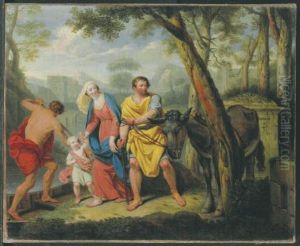Louis Fabritius Du Bourg Paintings
Louis Fabritius Dubourg was a Dutch Golden Age painter, born in 1622 in the city of Amersfoort in the Netherlands. Dubourg was known for his skill in painting, particularly in the genres of landscape and portraiture. During his lifetime, the Dutch Golden Age of painting was at its zenith, and Dubourg became a part of this vibrant artistic movement, contributing with his unique style and perspective.
Dubourg's education and early career were marked by an apprenticeship with local artists, a common practice of the time for budding painters. He might have traveled within the Netherlands or possibly to Italy, as was customary for artists of his era seeking to refine their skills and study the works of the Renaissance masters. However, specific details about his travels and early influences remain sparse.
Throughout his career, Dubourg developed a reputation for his landscapes that captured the serene beauty of the Dutch countryside, as well as his portraits that often depicted the wealthy and influential figures of his society. His landscapes were typically imbued with a sense of calm and harmony, reflecting the Dutch appreciation for their environment. Meanwhile, his portraits were celebrated for their detailed realism and the ability to capture the personality and stature of his subjects.
Despite his contributions to the art world during the Dutch Golden Age, Louis Fabritius Dubourg did not gain the same level of fame as some of his contemporaries, such as Rembrandt or Vermeer. This could be attributed to the vast number of artists working during this period, which made the art scene highly competitive.
Dubourg's legacy is preserved in various European art collections, showcasing his talent and giving insight into the artistic endeavors of the Dutch Golden Age. He passed away in 1696, leaving behind a body of work that, although not as widely recognized as some of his peers, remains an important part of the era's artistic heritage.
